arteducation
now browsing by tag
Anew Coming into View
Blog Post by:
Carrie Nordlund, PhD
Kutztown University of Pennsylvania
Another year is coming into view and we too are ceaselessly in a state of becoming (Unrath & Nordlund, 2009). The term epiphany is a Greek derivative meaning to come into view (McDonald, 2008). Some new year’s resolutions come into view from epiphanies, profound illuminations of experiences with subsequent and emergent crystalizing moments of self-identity (Nordlund, 2019). As we usher in a new year, we can revisit the crystalizing moments we have cherished and open ourselves to what may come further into view. We may also recall challenges as we attribute meaning to the past year, those paralyzing moments of the past. Yet, these too offer us opportunities to recommit our efforts in becoming our best selves. The new year brings into view potentiality, to become anew.
The new year can pose uncertainty. One way to take in hand the feelings associated with uncertainty is to start to recognize epiphanies, with their consequential understandings of our deeply held certainties and feelings about self and the world, often ensue after periods of inner turmoil including states of anxiety and depression (Denzen, 1989, 1990; Jensen, 1999; McDonald, 2008; Miller, W.R. & C’de Baca, 2001; Pyne, 2014). Jarvis (1997) defined epiphany as “sudden discontinuous change, leading to profound, positive, and enduring transformation through reconfiguration of an individual’s most deeply held beliefs about self and the world” (p. v). When we are called to deeply feel and consider, we have reconfiguration available to us to see and be anew.
How might we arrive at reconfiguration in the new year? To follow, I offer some strategies affording reflection and reconfiguration. In the past, I have facilitated these three strategies for and with K-12 students, preservice art educators and myself via action research aimed at working on being the best self I can be.
My Personal Art History
The first strategy, “My Personal Art History”, offers a means to consider how might we better recognize our relationship with art and if necessary, reconfigure our aesthetic code during the new year.
Carrie Miller, Artist Educator, North Schuylkill Elementary School
Identities are constructed artifacts. We tend to teach from what we know. Our past experiences with art and art education partly construct our present and future beliefs about art and art pedagogy. What journey brought you to the creating artist and becoming teacher you are today? What is your personal art story?
Reflect on your child and adult art story, aesthetic experiences of the past and blossoming abilities in and with art. Visually describe any crystallizing and paralyzing moments during your explorations with art. Recreate in a timeline of visual expressions and metaphors of this art history starting from your earliest memories to now, 2020. The timeline leads to you to defining a future aesthetic code.
Postcard Moments
The second strategy, “Postcard Moments”, offers a means to consider sudden, turning point moments of epiphanies that provoke transformation of our conventions (Miller & C’de Baca, 2001; Nordlund 2019; Unrath & Nordlund, 2009).
Amanda Madea, Community School Coordinator, Bethlehem School District
Postcard Moments are small postcard-sized expressions created at self-determined key moments. The visual metaphors express a moment of sudden enlightenment—an epiphany—accompanied by written narrative about the personal “aha” and journey to it. The small postcard format serves as a compact, portable, and focused place where these such reflections are actualized, just as a traveler might choose which external event or experience from a trip is significant enough to write home.
Postcard Moments can become a larger culminating artifact by juxtaposing and synthesizing individual epiphanal works from the journey (e.g. journey book, travel game, visual mapping, digital film, photomontage,…). “Ahas” along the way or during the journey, lead to enduring understandings relevant to the traveler’s transformation or the potentiality of transformation and are characterized by traveler’s comprehension of the intimately interconnected parts of something complex. Postcard Moments often provide acute awareness of vistas previously unseen (Nordlund, 2019).
Personal Improvement Plan
The third strategy, “Personal Improvement Plan”*, offers a means to design an action plan in the new year targeting a specific goal to become one’s best self.
Carrie Nordlund, Associate Professor of Art Education, Kutztown University of Pennsylvania
Visual Artifact from Steiner’s Six Steps in Self-development Exercises
What threatens or impedes you from being your best self? To engage in a Personal Improvement Plan (PIP), take on a self-designed project that helps you become your best self over the new year. Intentionally choose a condition or disposition that is lesser and needs to be made more significant, positive, and enduring by ascribing personal meaning to it through a plan of improvement. Allow yourself to be vulnerable to create a SMART (specific, measurable, achievable, relevant and time-based) goal as the core of your improvement plan.
My PIP goal typically starts as a wondering, such as “What might occur when I devotedly practice mindfulness exercises directed at educators?” To answer this question, my PIP plan entailed an autoethnography study over six months where I sequentially employed and maintained Rudolf Steiner’s (1910/2011) Six Steps in Self-development: The Supplementary Exercises for Teachers by implementing one exercise each month until all six were engaged in the sixth month. I discovered and described in narratives the deep meaning or essence of experiencing the phenomena of Steiner’s six supplemental exercises entitled (1) control of thoughts; (2) initiative of will; (3) equanimity; (4) positivity; (5) open-mindedness; and (6) equilibrium. The outcome narratives explicated the phenomena under investigation and became a means for intervention, i.e., action research on my own practices and state of being.
When you employ a Personal Improvement Plan consider weekly documentation of your progress, including dates and times, pictures, successes, failures, outcomes, notes, wonderings, insights, and implications. Feelings of doubt, immobility, or disconfirmation can be or lead to breakthroughs. Personal improvement plans can either target our individual best selves, or on a macro level, us as change agents for a global best self.
*The “Personal Improvement Plan” was created and championed by Dr. Peg Speirs, Kutztown University of Pennsylvania.
References
Jensen, K. L. (1999). Lesbian epiphanies: Women coming out later in life. Harrington Park Press, New York.
McDonald, M. G. (2008). The nature of epiphanic experience. Journal of Humanistic Psychology, 48(1), 89–115.
Miller, W.R. & C’de Baca, J. (2001). Quantum change: When epiphanies and sudden insights transform ordinary lives. Guilford, New York.
Nordlund, C. (2019). Letters to colleagues: A community of practice for navigating and reshaping identity. In Daichendt (Ed.), Visual Inquiry: Learning and Teaching Art, 8(1), 49–62.
Pyne, S. (2014). The role of experience in the iterative development of the Lake Huron treaty atlas. In Fraser Taylor, D.R. (Ed.), Developments in the Theory and Practice of Cybercartography: Applications and Indigenous Mapping, 2nd Edition (pp. 245 -259). Oxford, UK: Elsevier Science.
Steiner, R. (2011). Six steps in self-development: The supplementary exercise. Rudolf Steiner Press.
Unrath, K. & Nordlund, C. (2009). Postcard moments: Significant moments in teaching art”. In Dhillon, P. (Ed.), Visual Arts Research, 35(1), 91–105.
How Many More School Days Until Summer??
by Jessica Alesso
Oh, the holidays. A great time of excitement, joy, and revelry for most, paired with a bit of stress, busyness and travel, too much food and drink, and perhaps not as relaxing as we all had hoped. BUT, we as teachers crave this mid-year break, right? We are all anxiously—students and teachers alike—counting the minutes until that bell rings on the last day before vacation starts. We try desperately to keep them all engaged right up until the end, despite their antics and their evident desire to also be out of the building, sleeping in, opening presents, and enjoying this chance to recharge our batteries, at least a little bit.
I always have the greatest intention to bring a ton of grading home, but I inevitably push it off until the last day, and then have less-than-zero motivation to do it. Instead, I spend my time on Pinterest and YouTube, watching gelatin printing and mixed media videos and plotting how to use the techniques in my classroom. I also spend a fair amount of time “art-ing,” retreating to the studio, and refocusing my artistic energy into productivity rather than regretting the amount of carbs I’ve ingested and the amount of money I (over) spent. I often find myself making plans to continue my art mojo throughout the year too, as the creative momentum I build over the break will wane. As artists and as teachers, we need this time to just be, to think, to plan, and to live in the process, until the magic happens. After all, isn’t that precisely what we teach our students to do? So, as we count down the precious moments until we have to return to the daily grind and to help our darling students make artistic magic, let’s reflect on how we can keep our own juices flowing, until those last few days in June (that’s still six months away, right? Oh, boy).
-
Start a new art journal or sketchbook
One of my favorite ways to reinvigorate my artistic practice is to start a new art journal. A go-to gift that my family knows will please me is a gift card to my favorite art supply store. So I usually pick out my next sketchbook well in advance of Christmas, in preparation for that virtual money to start burning a hole in my pocket! That fresh, clean paper nearly screams to be covered in watercolor and acrylic, in chalk and graphite, and my latest material obsession: Distress Inks.
-
Sign up for an online workshop or class
I didn’t even realize how many options there were for this until a friend of mine suggested that we do one together. There are TONS of options out there, focusing on materials such as watercolor or fluid acrylic, paper arts, or polymer clay, or centering on processes such as collage, printmaking, abstract painting…not to mention those that are concept-based, such as “reclaiming your creative feminine energy” or “designing installations.” Just do some searching! Seriously, just Google “online art workshops about ______.” Whatever floats your boat, you will be able to find an online experience to suit you. If you don’t have the cash for that option, plan to view some PAEA WebinARTs! Check for new content by clicking here: WebinArts
-
Set aside time for creative goal-setting
This is one I struggle to do sometimes, but I always have a more productive year of art-making when I do it. Before the crazy of the latter half of the school year starts, set aside a weekend day or evening to look ahead for upcoming opportunities. My local art museum has an adjudicated spring show, in which I have sporadically participated over the last decade, and I know if I planned ahead for it, I’d be motivated to make more work. A few summers ago, some friends and I planned a group show for a small local venue. Having the accountability of a group was essential for me to push through and make art, and ultimately, I came up with some of the best work I’ve made in several years. If you can dream it, you can do it, right? I know I’ve had that quote on a poster in my classroom at some point. Walk the talk.
-
Make time for art in your week
This is a practice that has made a world of difference for me this past year. In June, I had breast-reduction surgery, and I was laid up for almost the rest of the summer. Making art was about the only thing I had energy for during those first few weeks post-surgery, so I was forced to indulge myself in painting, Gelli printing, playing with watercolors and the myriad markers I’ve stockpiled. I even revamped my art website (well, started it anyway…that takes FOREVER, and I have miles to go). When school started, I made a point to continue my studio time for at least one day a week. Though it may only be for 20 minutes here and there, I’ve kept at it and nearly filled an entire sketchbook.
-
Find (and engage with) your tribe
This is one of my favorite “art” practices, and I always feel justified making time to hang out with my art/art teacher friends, since I’m supporting my creative identity and satisfying my penchant for being a social butterfly. Finding those people who get us, and who get what we do on a daily basis, can be a huge benefit for us; energetically, spiritually, emotionally, and practically. Most of the inspiration I get for my own art is from collaboration with friends and colleagues. This is perhaps the main reason I attend the PAEA conference. Not only do we get Act 48 hours and great insights into new methods and materials, but we also get to hang out with our tribe, our people, and art-nerd out together!
Jessica Alesso is a secondary art teacher in Erie, PA and the Region 2 Representative for PAEA. Jessica is also the co-chair for the 2020 PAEA conference committee and is excited to welcome Pennsylvania’s art teachers to Erie in the fall.
PA Arts and Culture Advocacy: Engaging Students in the Political Side of the Arts
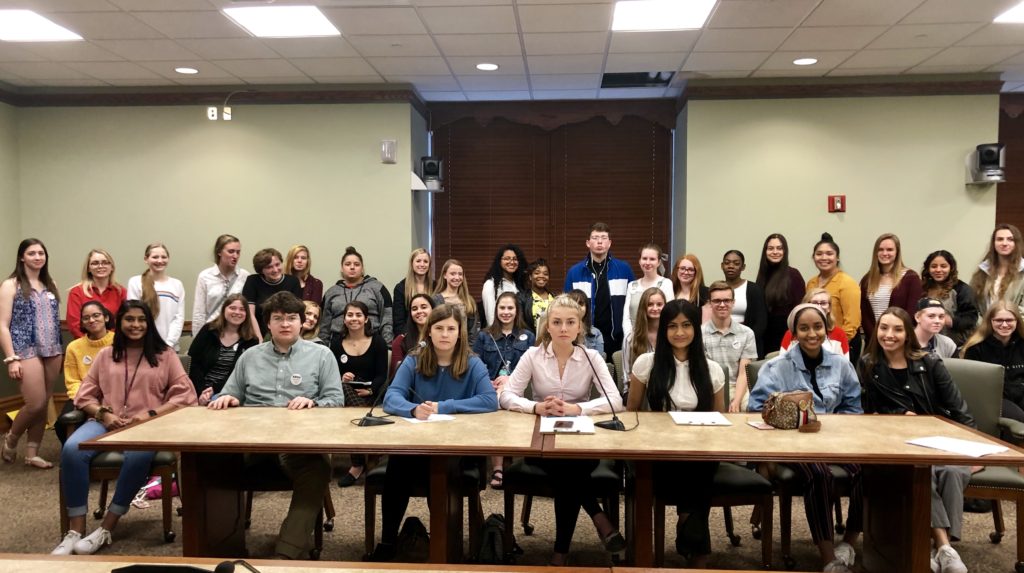
Post by PAEA board member Jessica Kirker
“I only need to pass my ‘important’/core subjects.”
“[Student] is going to have to miss art today because of discipline/make-up work/test prep.”
“I can’t expect [child] to do well in art, I can’t even draw a stick figure.”
“It must be fun/easy to teach a class that all students enjoy.”
“How can your really grade art? Art can just be whatever you want, right?”
I am certain, beyond a doubt, that I have the best job in the world. If you are reading this blog, you probably do to! We, as art teachers, have so much to be grateful for. We have the privilege of enlivening the creative spirits of those whom we teach. Art teachers can foster a means to communicate beyond what a student expects or imagines of themselves. We can open eyes, heads, and hearts to media and methods that our students didn’t know existed. We get the chance to re-experience the joys, excitement, and apprehension of these materials and tools for the first time over and over through our students. While students transition through grades and classroom teachers, we get to stay with students for years and have the chance to build meaningful and lasting relationships.
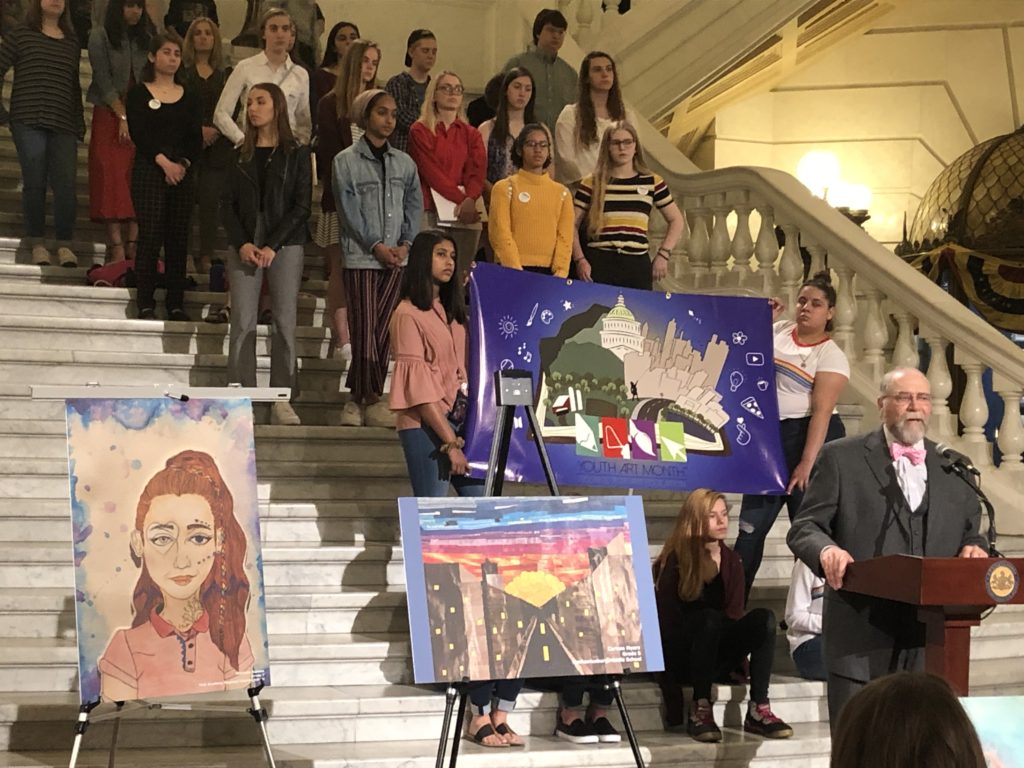
However, some times, (ok, many times) we have to grit our teeth to the misnomers that come from a lack of understanding about what we do, and most importantly, why we do it. The readers of this blog know that we are not the educators of fluff, fun time, brain breaks, hobby hour, extra recess, or easy ‘A’s’. Sometimes these misnomers are cruelly condescending and other times they are ignorantly based on affectionate nostalgia. Whatever the reason, these perspectives are damaging to the future of art education for all students and we can not allow them to continue.
NAEA and PAEA both provide strong support for art education advocacy. (Have you checked out their websites lately? NAEA: https://www.arteducators.org/advocacy PAEA: https://paeablog.org/blog/.) NAEA offers a multitude of materials to assist art educators in preparing to advocate to school, community, and legislative audiences. These well-articulated resource guides plainly and effectively describe the importance of art education for all students and are easy to be shared with educational community stakeholders.
I am proud to report that this year some members of the PAEA Secondary Division incorporated high school students into their advocacy plans for PA Art Education by bringing approximately 50 high school students together for Pennsylvania Arts and Culture Advocacy Day in Harrisburg on May 1. This event was sponsored by The Citizens for the Arts in PA and exposed students to the political side of the arts while showing our legislators the importance of art education on a very tangible and personal level. The art teachers from Norristown Area HS, Garnet Valley HS, Cumberland Valley HS, Conrad Weiser HS, and South Western HS each brought between 5 and 15 students to participate in the day’s events. The majority of these students were members of their school’s National Art Honor Society Chapter.
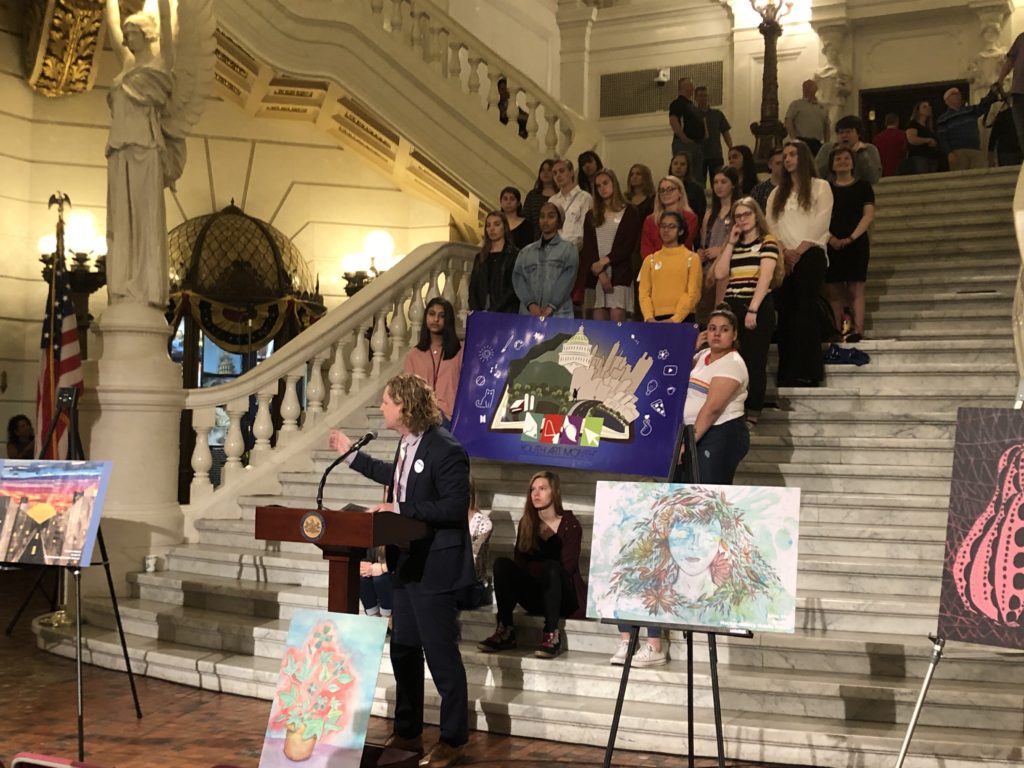
The day began with an Arts Caucus breakfast followed by a press conference in the Capitol Rotunda. During this time, some high school art students proudly displayed the PAEA 2019 Advocacy Flag in the backdrop for the speakers. Easels of PAEA Youth Art Month surrounded the podium and Rotunda stairs, attracting the attention of those that passed by. Meanwhile, other art students grabbed their pencils/pens/markers/charcoal and began drawing the architectural landscape of the building as observers got the opportunity to see our talented students at work. These working artists put the process of their craft in the limelight to the capital audience.

After the press conference, some students took part in tours while others continued drawing exercises or moved on to legislative meetings. Jenny Hershour of Citizens for the Arts in PA coordinated the meetings between participating schools and local legislators so that they could engage in conversations about the importance of arts education from the perspective of those whom are directly served. This gave the students the chance to speak from the heart about their passions, inspirations, educational experiences, and hopes for the future of art education.
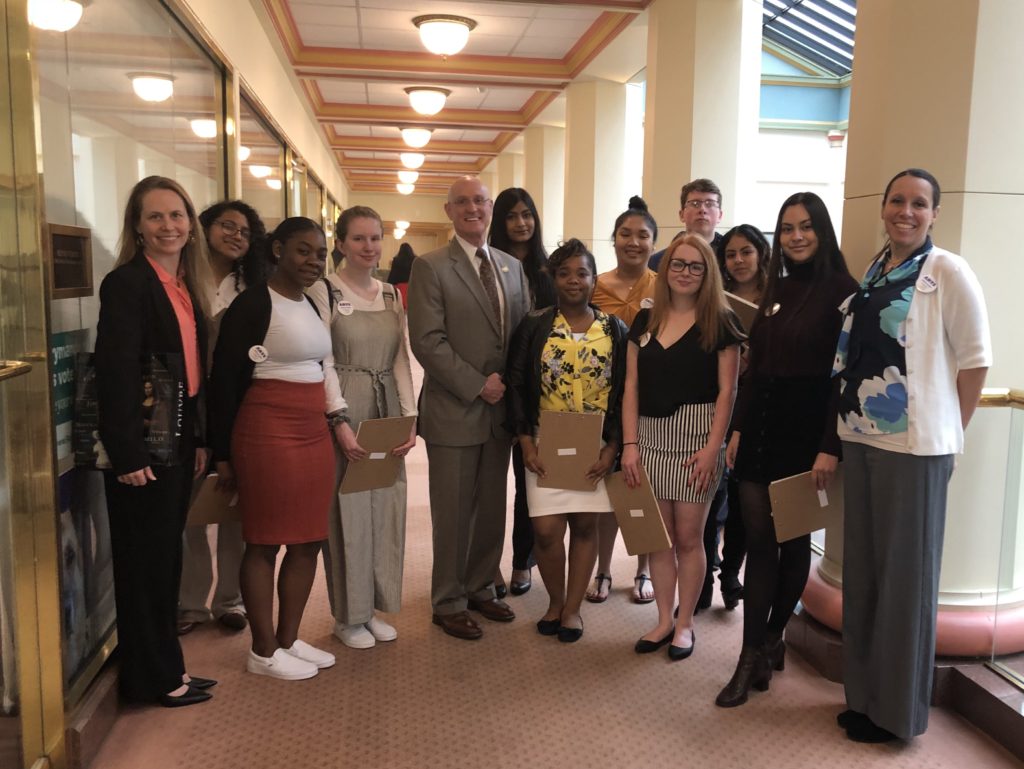
All students attending had the chance to get together over lunch where they were assigned to tables with youth from other schools. Uncomfortable at first (as you can expect of any high schooler), the tables transitioned from shy nerves to lively chatter and laughter by the end of the afternoon. With the conclusion of
Not only did the students get the chance to have their voices heard and create visibility for the visual arts during this event, I believe the most impactful outcome of the day was the effect that this even had on our students. Many high school art students are familiar with the misnomers surrounding art classes. By the time they have reached high school or advance level classes, there has been some tough choices to be considered. Do I take another year of language or try for AP studio? Do I need another math class or can I take Art II? Will it affect my GPA if I take non-weighted art classes? Do I want a career in art? Whatever their reason, these students have chose the path of including visual art into their educational path, and they might have had to defend this choice to peers, teachers, or family members. Are they prepared to successfully articulate their position? We, as members of PAEA/NAEA have been prepped for these conversations, but what about our students?
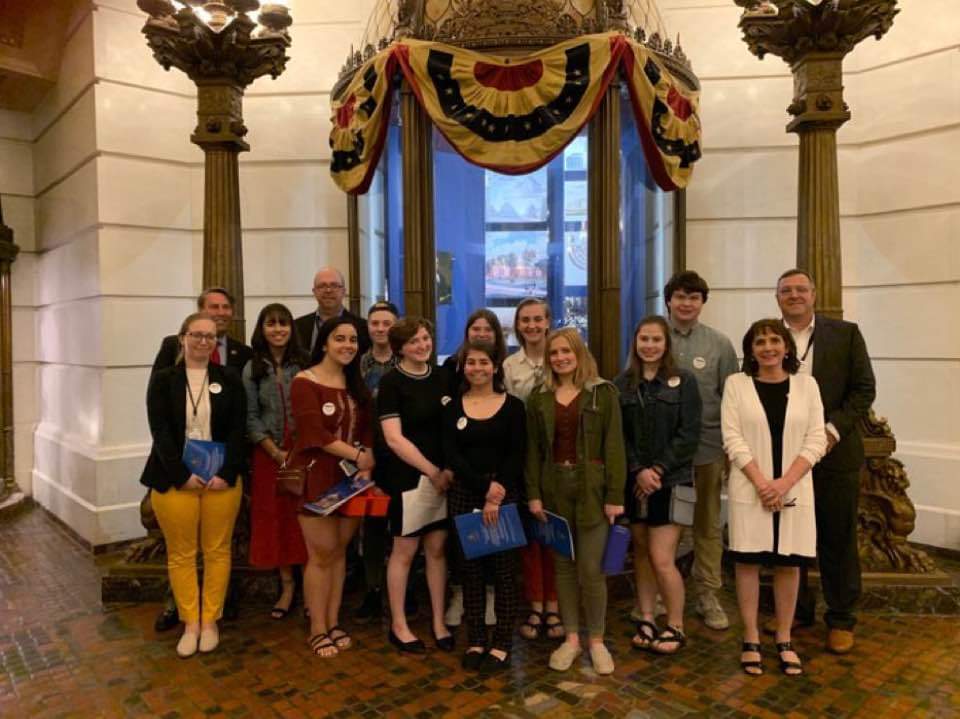
If a student is going to join the art world as full-time or part-time professional artist or art educator, patron of the arts, or supporter of the arts, s/he are members of an arts community that does not exist in the solitude of his/her own space. We teach our students that art is social, political, emotional, and environmental. Therefore, engaging the arts world is also a socio-political activity. If we teach students how to make art, talk about art, analyse art, and write about art, then we also need to consider it our duty to teach our students to be citizens for the arts.
There is evidence to support the notion that regular exposure to art classes enhances proficiency in math and reading. Can we look to sociology to enhance our understanding of art or government/social studies classes to enhance our roles (or our students’ roles) as art advocates? It is not rare for my high school art students to believe that their passion for art is not entwined with politics, but that is far from accurate. I often remind them that that every class, every dollar spent on classroom materials, and the mere availability of the classroom/space/instruction is a product of a local/state/federal legislative decision.
By the time a student reaches an advanced level high school art class, they should become aware that art class is not a privilege for a few, but a right to all as per ESSA. They should also be aware of the local and national legislative trends regarding arts in education. If they are going to become engaged in the art world as a youth and adult, they have to understand the role of free and adequate public arts education to sustain the future of arts in their community, state, and country. Students also need to understand their role as a voting citizen, a voice for their community, and an advocate for their own passions.

Participation in PA Arts and Culture Advocacy Day not only put a visual presence of visual arts education at work, but it gave students a chance to witness the democratic process and what it means to be an advocate for their cause. I encourage all PAEA/NAEA members to continue their advocacy efforts in their school, community, state, and national forums. I also encourage you to invite your students, parents, and colleagues to act as advocates for art education. If we fail to address the political nature of arts funding, access, and education, then we fail to educate the complete picture of the artworld in the 21st century.
Jessica Kirker, PhD is the PAEA Secondary Division Director. She teaches art at Norristown Area High School and is an Adjunct Professor of Art Education and Community Arts Practices at Temple University Tyler School of Art.
“Make It Work, Artists!” : Mini Design Challenges for the Art Room
Sunnylee Mowery, PAEA Secretary and art teacher extraordinaire at Greenfield Elementary in Philadelphia, shares her ideas on using mini “Design Challenges” to encourage collaboration and increase spontaneity between traditional lessons. Great for half days and early dismissals! Sunny shares with members her experience and provides readers with a few easy, no mess, minimal prep ideas.
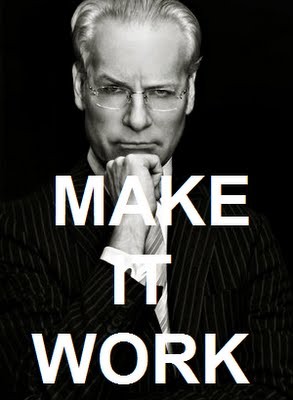
The digital clock counts down! Sweat drips for the contestants’ foreheads! Expert judges lined up at a table to offer cut-throat feedback! By this point we’re all familiar with reality competition TV shows and most recently, I’m sure you’ve noticed the evolving trend of our kids creating their own idiosyncratic challenges. Epically perfect water bottle flip onto table edge, anyone? In an effort to harness the energy behind our human desire to compete, I started implementing “Mini Design Challenges” into my art curriculum and my students have responded with rave reviews!
So what is it? A design challenge is a brief, yet intriguing art prompt that students work to complete as a team. Design challenges are great for encouraging collaboration and increasing spontaneity between traditional lessons. They are a great fit for all grade levels, and demonstrate that the work of an artist isn’t just about making a masterpiece with strong elements and principles.
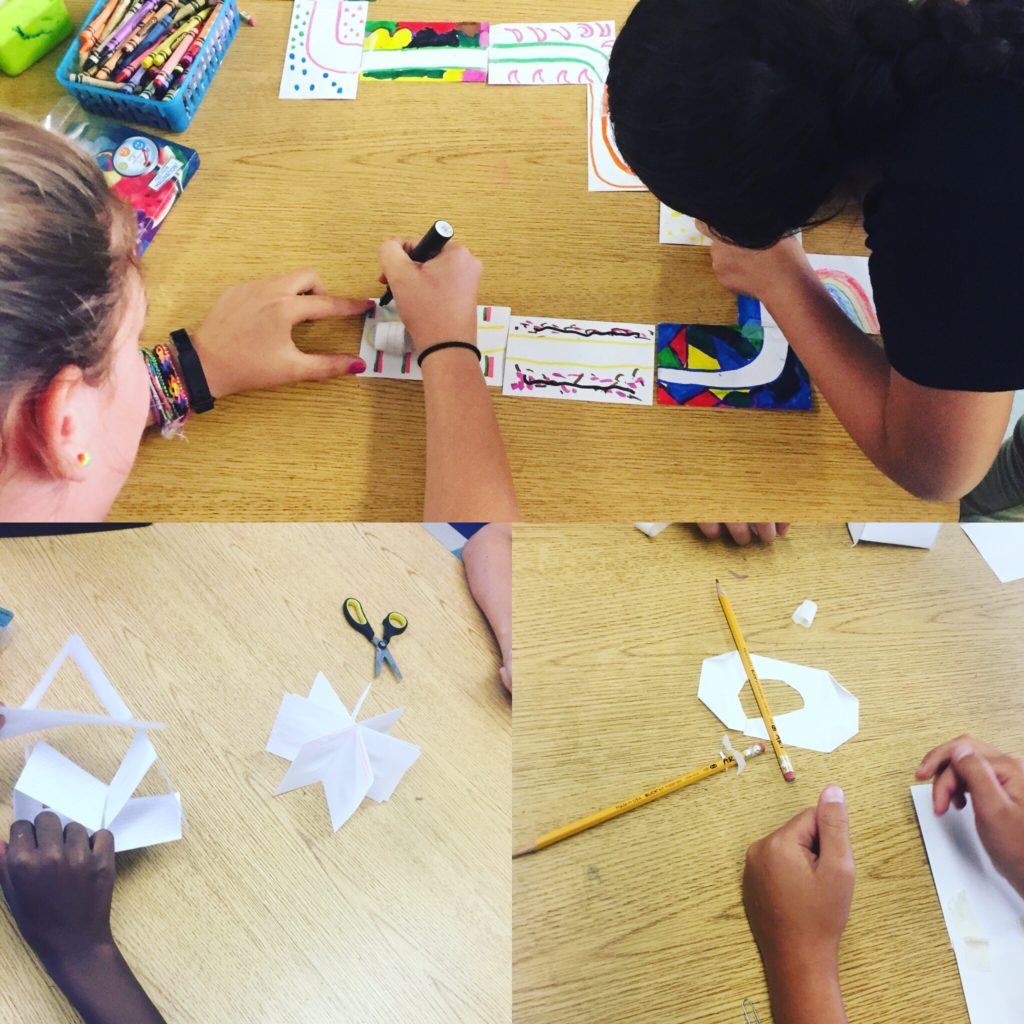
What I love most is that the design challenge format flips the traditional art room modus operandi on it’s head. Instead of coming to art and embarking on a personal journey of completing project objectives, I design my challenges to get kids up out of their seat and collaborating. Disclaimer: A successful design challenge may result in a room that’s louder and messier than normal! It also requires a fair share of masking tape. But for most design challenges, all you need are some recycled materials which is great for ye old budget and a boatload of fun.
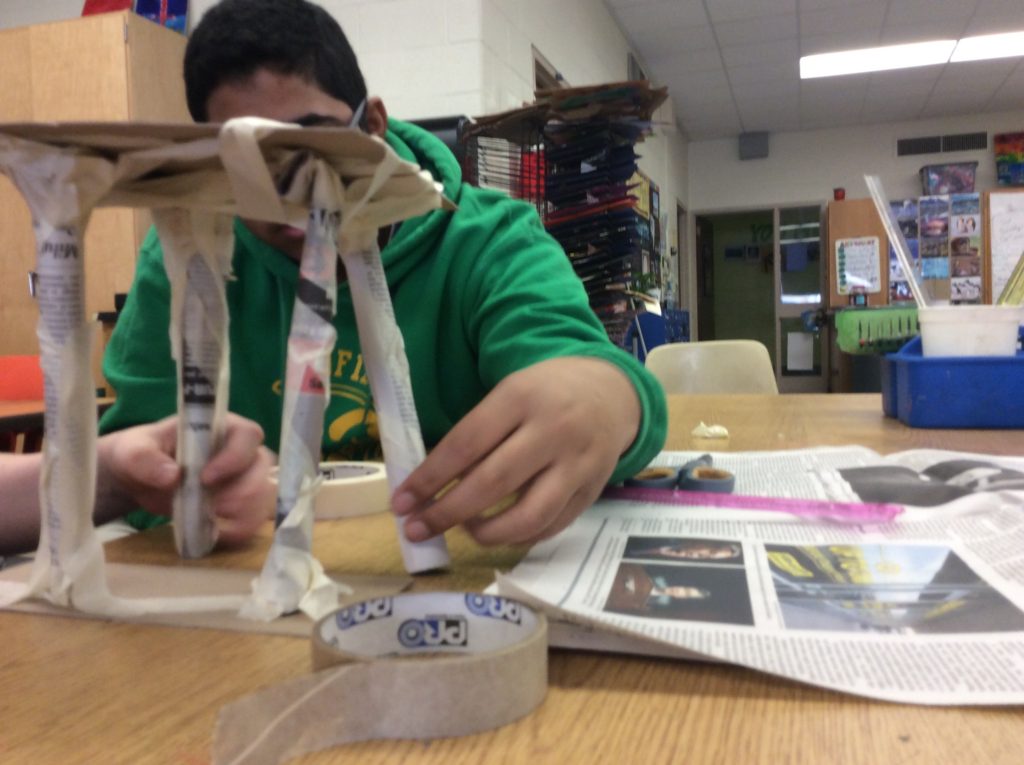
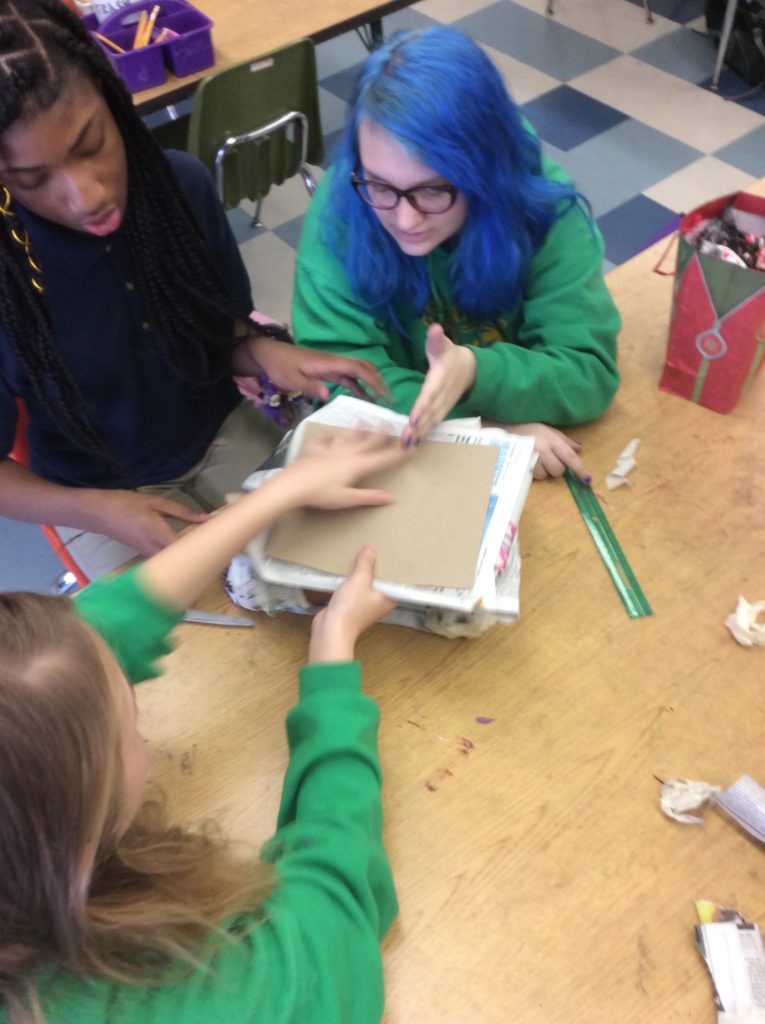
I try to announce the prompt, material guidelines, and rules in less than one minute (time is of the essence!) and I make sure to provide a visual of all the parameters on the board for those that have any questions. And then boom, it’s on your mark, get set, let’s go!
Below is a list to my go-to art design challenges:
· Build a shoe out of newspaper!
· Build a table out of recycled materials that can support the weight of a dictionary.
· Create a kinetic sculpture out of 20 blank index cards.
· Create the longest line you can using only three sheets of paper and tape.
· Create a hat you would wear if you were a style icon.
· Work as a team to use each material in the “Mystery Bag” at your table to create one, complete masterpiece!
· Marshmallow Spaghetti Challenge: Using only tape and 20 piece of spaghetti, build a sculpture that support the weight of a marshmallow.
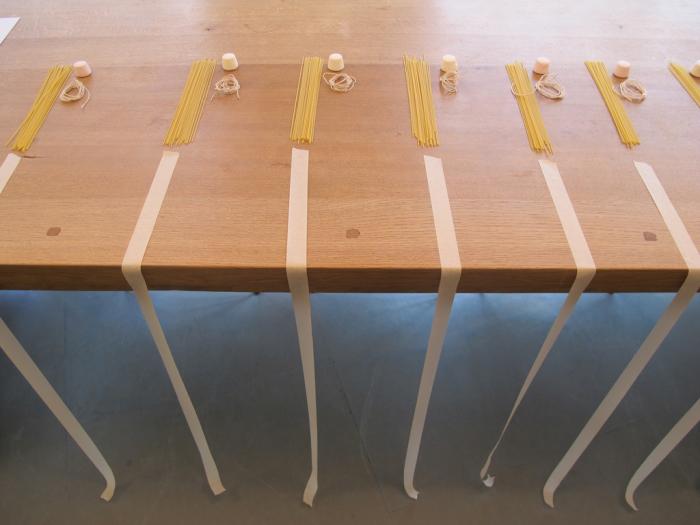
Kiddos usually get 20 minutes to complete each challenge. this chance to work as a team encourages peer to peer dialogue. Kids are forced to negotiate group troubleshooting and solve problems together on the spot. These kind of artistic endeavors help them build social skills in a low-stakes, fun oriented environment.
My favorite part of each day is the big reveal and the debrief! It’s important at the end of each design challenge to take a moment and let the students observe the way other teams solved the problem. There are so many gorgeous moments of delight and exclamations of reverie.
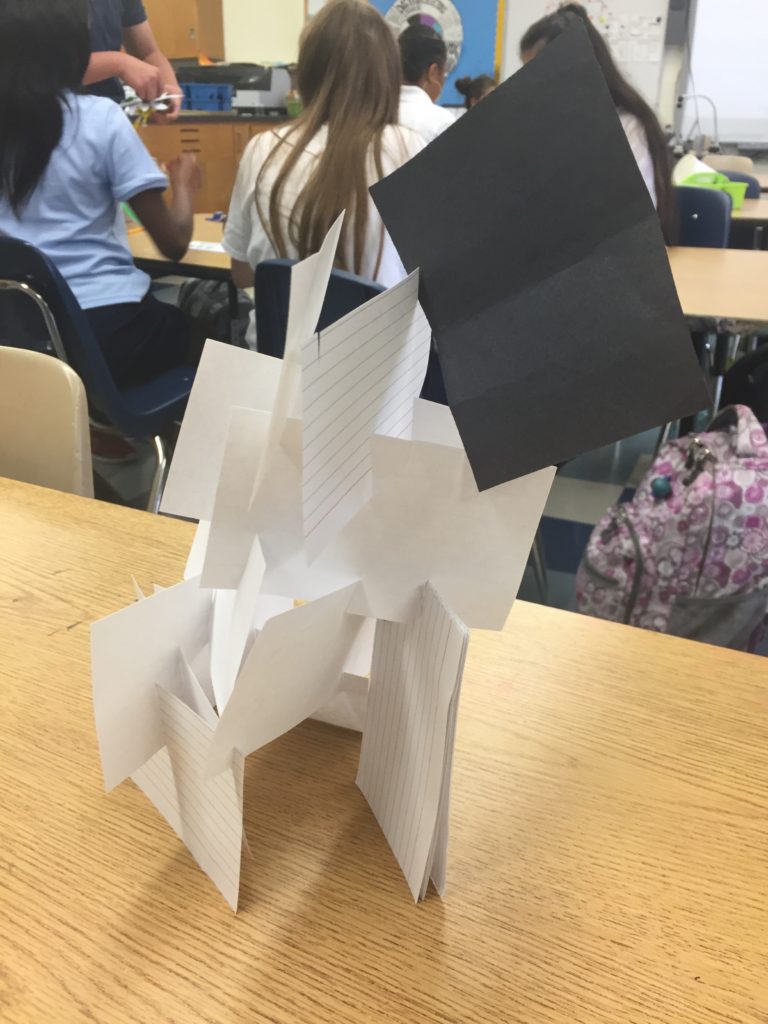
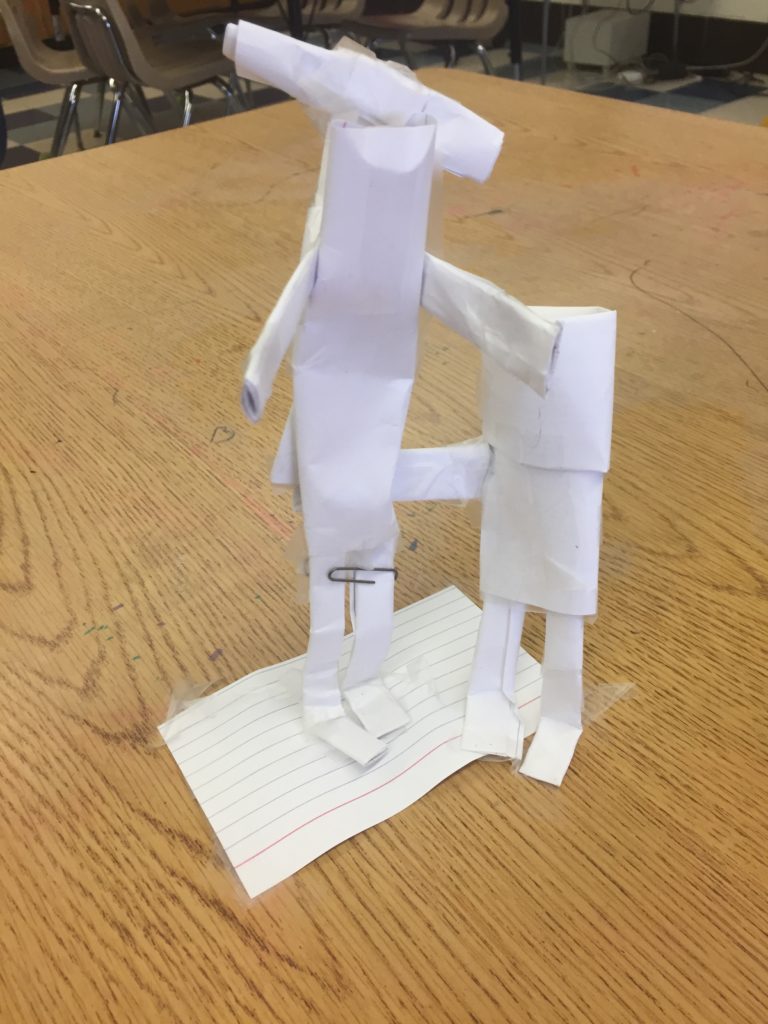
To prompt reflection-related dialogue, I usually wrap up with three simple questions:
· What was the easiest part of this challenge?
· What challenges did you encounter? How did you solve these?
· How did you break up the job with your teammates?
My students have come to expect four design team challenges each year. I like to throw them in on half days when classes are condensed to 30 minutes. I keep the stakes low, no one is voted off the island and no one is asked to pack their knives and go. Sometimes there are obvious “winners” and sometimes none of the teams complete the challenge prompt completely. Both results are okay. If I did a good job as a teacher, my students walk away knowing the joy of just engaging in the design process.
The Art21 Experience, by Marie Elcin
Philadelphia art teacher, Marie Elcin, was one of ten art teachers from across the country to attend the Art 21 Summer Institute Workshops in New York City. What an honor for Marie, and how exciting for us to hear about her experience!! Perhaps it will inspire you to be one of the next Art21 educators? Thank you Marie for putting this blog entry together (and on such short notice!). Here in her words, Marie tells us about her Art 21 experience in NYC:
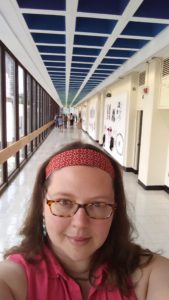 “When I attended Joe Fusaro’s session about ART21 at NAEA in New York this past March, I knew this was the year I had to go for it: apply to be an ART21 educator. The application involved writing about my viewpoints on contemporary art and how I use it in the classroom, and writing up a sample unit plan for a contemporary art experience. The fun, but challenging part of the application was filming and editing a 5 minute introductory video (https://youtu.be/D4b61PPRLvI )to explain why I wanted to be in the program (they like to see your personality and tech skills!). When the acceptance announcement came out, (https://art21.org/2017/06/06/welcome-to-our-new-art21-educators/ ) I was over the moon with excitement and anticipation, and I couldn’t wait for the school year to hurry up and finish already so I could get to New York City.
“When I attended Joe Fusaro’s session about ART21 at NAEA in New York this past March, I knew this was the year I had to go for it: apply to be an ART21 educator. The application involved writing about my viewpoints on contemporary art and how I use it in the classroom, and writing up a sample unit plan for a contemporary art experience. The fun, but challenging part of the application was filming and editing a 5 minute introductory video (https://youtu.be/D4b61PPRLvI )to explain why I wanted to be in the program (they like to see your personality and tech skills!). When the acceptance announcement came out, (https://art21.org/2017/06/06/welcome-to-our-new-art21-educators/ ) I was over the moon with excitement and anticipation, and I couldn’t wait for the school year to hurry up and finish already so I could get to New York City.
Left: Leonardo Drew’s Studio
Right: Selfie with Calder at the Whitney
After traveling up to Manhattan on the 4th of July, we had a whirlwind week through the Whitney Museum of Art for workshops to Brooklyn for a visit to the studio of Leonardo Drew and Dieudonne for a paper-pulp painting workshop, to the Museum of Natural History for an institutional/curatorial critique with artist David Brooks, to a New York Public High School classroom to brainstorm with teens, and to the Kitchen for a performance by artist Aki Sasamoto.
Left: David Brooks and Joe Fusaro at the Natural History Museum
Right: Dieudonne Paper Pulp Painting Workshop
Left: Open Spaces Brainstorm
Right: Glen Ligon at Harlem Studios Museum
Along the way we had time to explore NYC museums on our own (hello Harlem Studio Museum!) and time to work and process the experience to start developing our own resources to use in the classroom. It was the best professional development I’ve ever had because we got to see art, meet artists, make art, and learn best practice from our peers through hands-on learning- not boring lecture.
 I thought when I applied to the program that it would be just a one-year experience. What I’ve really become a part of is a community of educators around the country who are dedicated to ongoing professional development and collaboration with the focus on how to use contemporary art in the classroom. Not only was my 2017 YEAR 7 cohort of 10 educators from around the country attending the institute, but nearly 20 other educators joined us from past cohorts to introduce us to the practice of being an ART21 educator. Throughout the next year I’ll be collaborating intensely with members of my cohort and our mentors, but once an ART21 educator, always an ART21 educator.
I thought when I applied to the program that it would be just a one-year experience. What I’ve really become a part of is a community of educators around the country who are dedicated to ongoing professional development and collaboration with the focus on how to use contemporary art in the classroom. Not only was my 2017 YEAR 7 cohort of 10 educators from around the country attending the institute, but nearly 20 other educators joined us from past cohorts to introduce us to the practice of being an ART21 educator. Throughout the next year I’ll be collaborating intensely with members of my cohort and our mentors, but once an ART21 educator, always an ART21 educator.
I’m still figuring out what that will mean to me moving forward. The goal is to think about how to make learning in the art room inquiry based and not merely expressive. Contemporary artists research and explore ideas and questions that drive their practice- so students should be working in similar ways. How can we get students to ask questions and be motivated to find out the answers or experiment with ideas and artistic processes? How can we create dialogue and reflection in the classroom when those big questions lead to difficult conversations? How can we encourage innovation and creativity among our students?
Fortunately, there is a wealth of resources available on the ART21 website to use as inspiration. Check out the Learning Library page, which has questions and prompts with related artists to look at:
https://art21.org/for-educators/tools-for-teaching/learning-library/?filter-media-material=The educator guides that accompany each season are all available as pdfs: https://art21.org/for-educators/tools-for-teaching/guides/educators-guides/
And now that the website has been revamped, each video is cross-indexed so you can see everything about a single artist that is available, including videos, image libraries, and articles.
Finally, ART21 puts out a monthly online magazine with info about artists and increasingly, articles by ART21 educators about how they are implementing contemporary art-based curriculum in their classrooms. http://magazine.art21.org/
Organization in the Art Room
The following query was posted to our PAEA Facebook Page. Members chimed in, and their responses are below for your benefit and organizational enjoyment! I’m getting goose pimples already thinking about the wonderful ways to organize!!!!
“Please share some of your unique and successful classroom organizational devices/structures. How do you store 2-D work? How do you store 3-D work? What do you feel is necessary to always have on the table? What are your art room life hacks? Etc…”
Marita Fitzpatrick of Bodine High School in Philadelphia suggests: “For small 3d (our recent stuffed toys): I have a copy paper box for each class. The students put their work in manila envelopes, write their names on them and I have one person from each table collect the envelopes and return them to the box. For 2d, each table puts their work in folders marked w the table color (tables are color-coded) and that goes in the copy paper box. This box is marked, period 1, period 2, etc. I have a closet of shelves for ceramics and each kid gets a shoe box to store their stuff in. It keeps the others from touching the work and breaking it. Students wrap their work in dry cleaning plastic to keep it moist. I regularly have kids empty the drying rack, sort the work and put it in the copy paper boxes. I keep nothing on the tables, because the stuff disappears and they put trash in the containers. I store markers and colored pencils in plastic pencil boxes on open shelves in the room and number them. I never look at the numbers or count them, but the kids think I do, so nothing disappears. On those shelves, I also have scissors and other frequently used supplies that students have open access to.”
Alison Elizabeth of Lancaster, PA shares her planning strategy: “Each class I teach is a different colored sticky note. This calendar is glued into the front of my sketchbook (which I use for all of my demos, meeting notes, and conference notes). It’s all with me and ready to go at all times.”
Linda Keels suggests making the investment in folding tables from the local hardware store (she uses 3) for about $30-40 a piece—there is room to hold up to 6 classes worth of work (she teaches 12) which forces her to keep it moving and the kids to stay on track for 3-D things.
Eleanor A-Evans For stores 3D work, such as clay sculptures and paper mache on ‘mobile pan racks’ (like the one in the photo- thanking Google image search). Depending on your supplies resources, the cost on the average is under $90, and can be the solution for saving space and stowing away the masterpieces!
Julie Schedin share with us how her students creatively tackle this issue with a little design thinking! “My Crafts class yarn bombs a coat hanger. They own the airspace above their seat, and hang all work (basket weavings, etc) from the coat hanger in the drop ceiling. The room develops a type of “rainforest canopy” but a least we can keep 3d projects organized and handy.”
Judi Treffinger of Carlisle, and formerly the Carlisle Area School districts has an idea for yarn storage! “You know all those large gallon sized plastic food containers your cafeteria gets when they purchase food? I duct tape then together with the open sides up and use them to store and separate skeins of yarn. They can sit on a counter top, or stash neatly in a cupboard with open ends facing out- all colors are visible and yarn doesn’t get tangled!”
Moore College of Art and Design Alumni, Autumn Rae suggests art teachers to follow her Instagram: mrsdow_artroom where shes posts things about classroom display and specific grade levels k-5 . She posts lots of classroom things about organization what materials I use.
Autumn also shares:
“- Container store bins are the best!
– It needs to be organized and colorful for me to function. I cannot stand messes or piles.
– I keep messes at the middle table whenever possible.
– I use my drying rack when I can but I actually love rolling out a sheet of paper and either working on the floor with the kiddos or having them dry their work flat and organized on a sheet of paper. Work great for printmaking each student gets a row for all their prints.
– All my notes are on my Instagram that describe each photo and what it relates to classroom, display, or a grade level.”
Autumn teaches art to 881 students k-5 students. She describes, “We are an emotional support school with a high ESL population and also a title 1 school. I have put lots of my own money into my class but once the upfront cost is paid off then I have all these organizational systems in place for years to come. I need everything organized like I said but also kid friendly. I have created two closets for classroom teachers and stock it at the beginning of the year so they don’t ask me for supplies I need for my own classes.”
Woah Autumn! Thanks for all of that!!! Loooooove the colors!!! And there is no denying where those pencils came from!!
Daisy Konowal uses a system of table color folders. 2 sets- one for work in progress and one completed work. Also, Daisy uses sheets/fabric/blankets to cover her shelves to limit access to shelves.
Sunnylee Mowery of Philadelphia’s Greenfield Public School strives to make my classroom organization methods so easy a kid can do it! Each table is color coded and this helpful chart rotates at the start of each week so everyone knows who is in charge of what. The artists are expected to pass out work and supplies, monitor volume, tidy table bins and floors, and even call each other to line at the end of class.
Sunnylee has clearly labeled bins with teacher name are organized by grade level. All supplies that accompany the project are placed above in their grade section.
Sunny poses the question, “How do students monitor sound, you ask? The volume giro migrates to the table in charge of volume each week. If the room gets too noisy, the students “ring” the giro to signal to the class to quiet down. If we get 3 giro rings, we lose the privilege to talk.”Click Here for a link to the video of the magical giro sounds that have the power to quiet students!
Kim Horan Colasante, art teacher in the School District of Philadelphia shares, “My routine is very much the same as Sunny’s. Each table has a color, table folders or student folders are matched to the table they sit at. I have a job chart, students give out folders, supplies, paint patrol, and floor sweepers. Jobs rotate weekly according to table colors. Supplies are located in front of the room and Barney’s Cleanup song plays at the end of every class 10 minutes to go. The students know to stop, put their work away and do their jobs. The ones that are done sing to barney. (I teach middle school) they dab to it also. It only plays for a minute so work must be away by the time song is done. then folders are collected and floors swept etc. 3D work is done a bit differently due to lack of space in classroom. When Barney plays each table brings me their 3d work and I place it in a special section so that they may retrieve it the following day. Clay is kept in large Rubbermaid containers until in it ready for drying.”
What do you do in your classroom?????

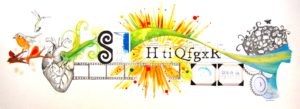
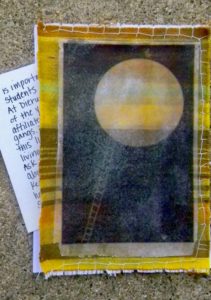
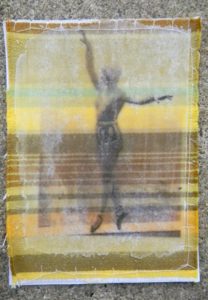
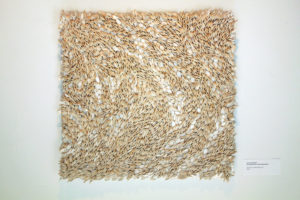




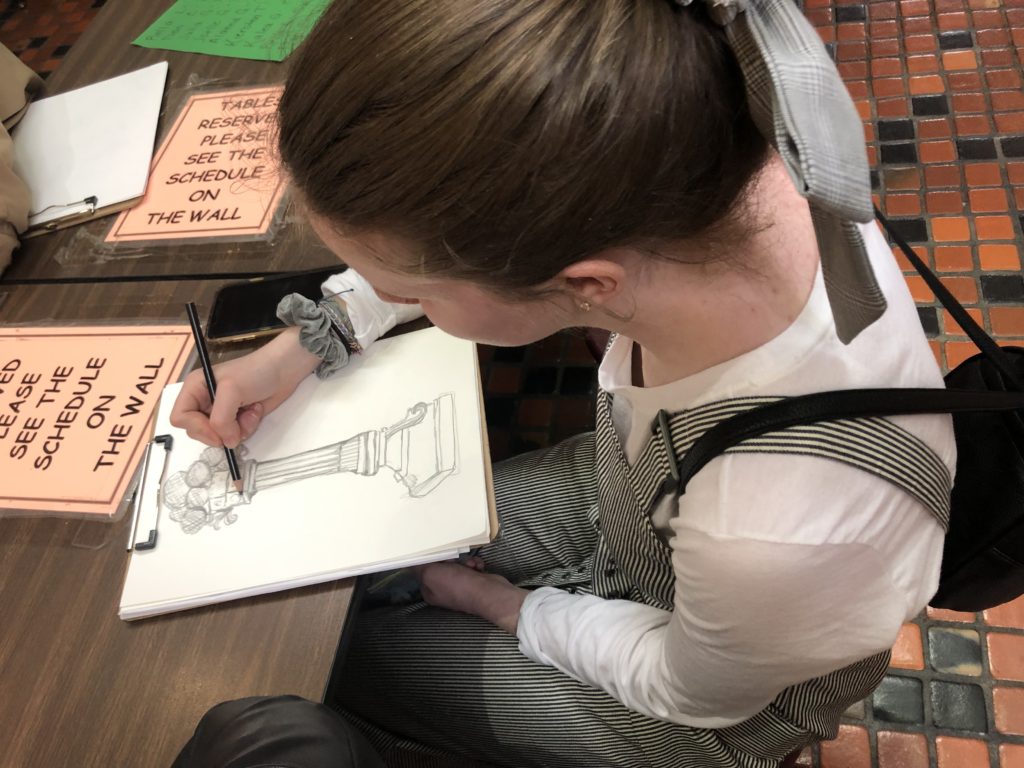
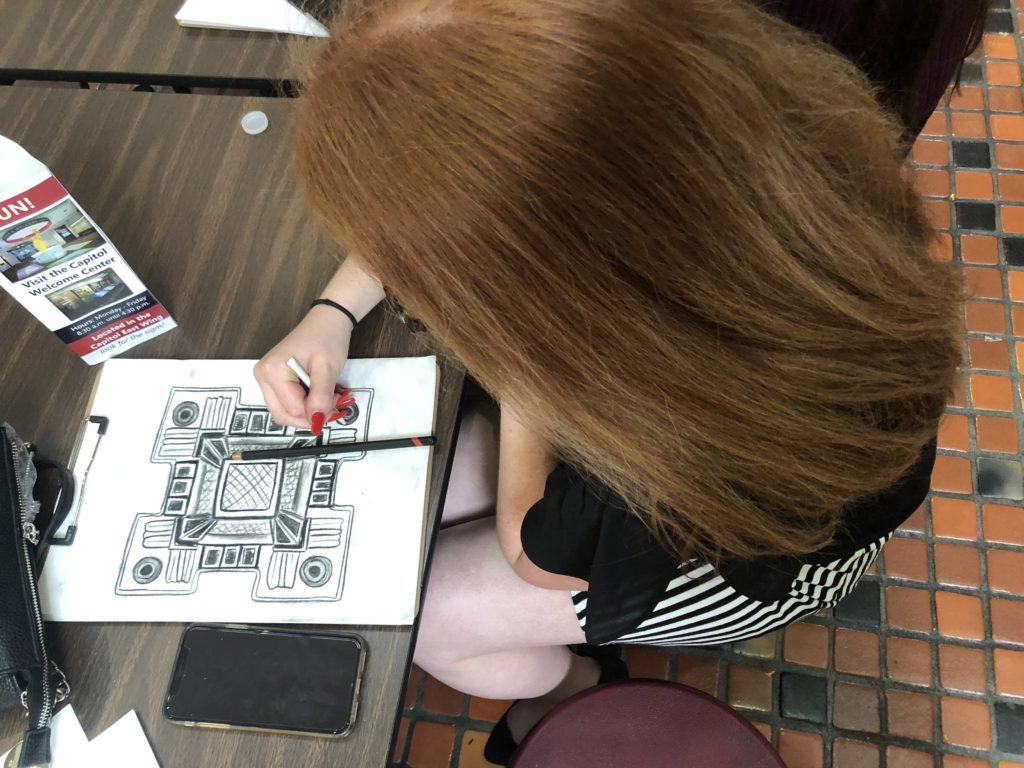
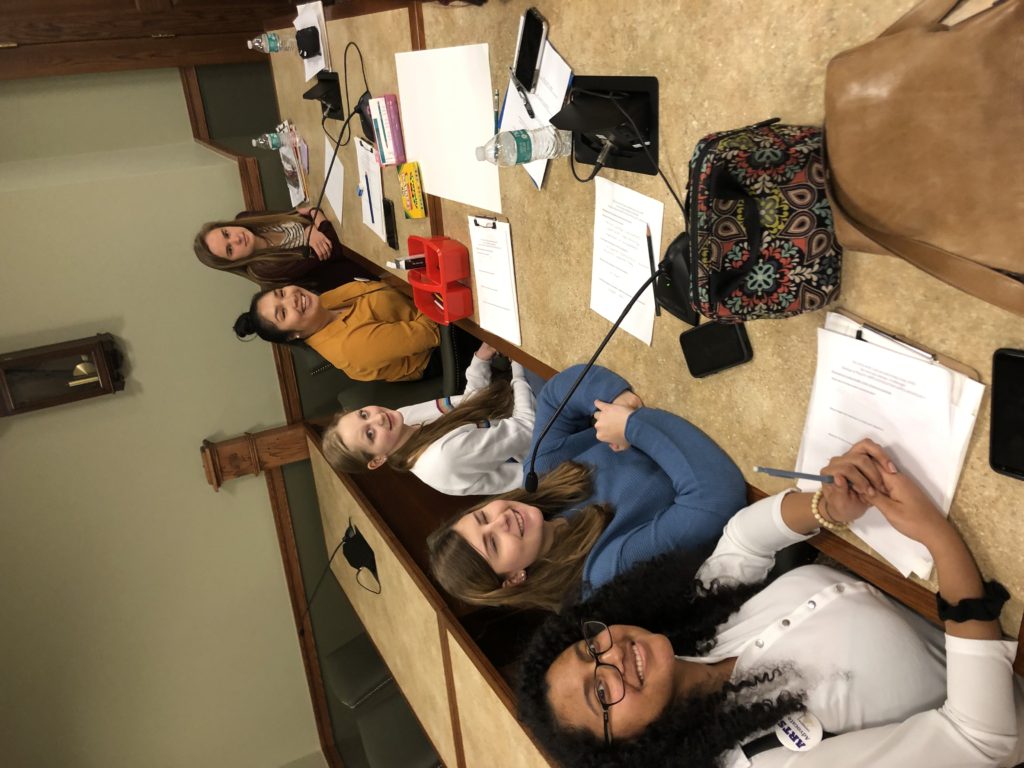
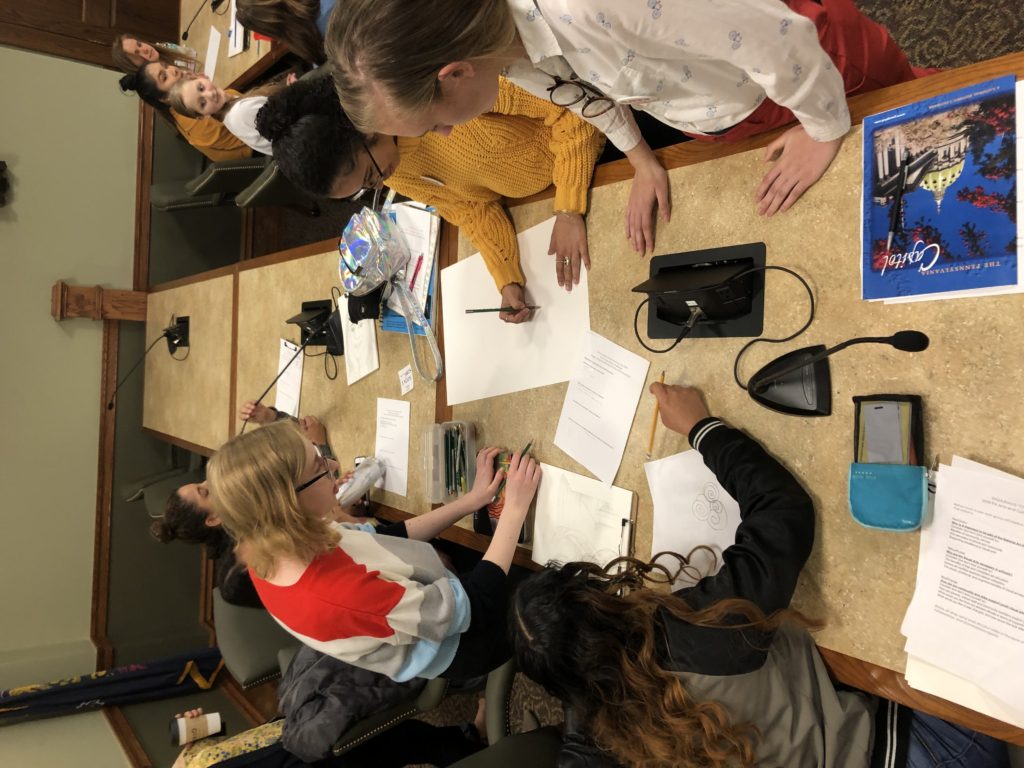
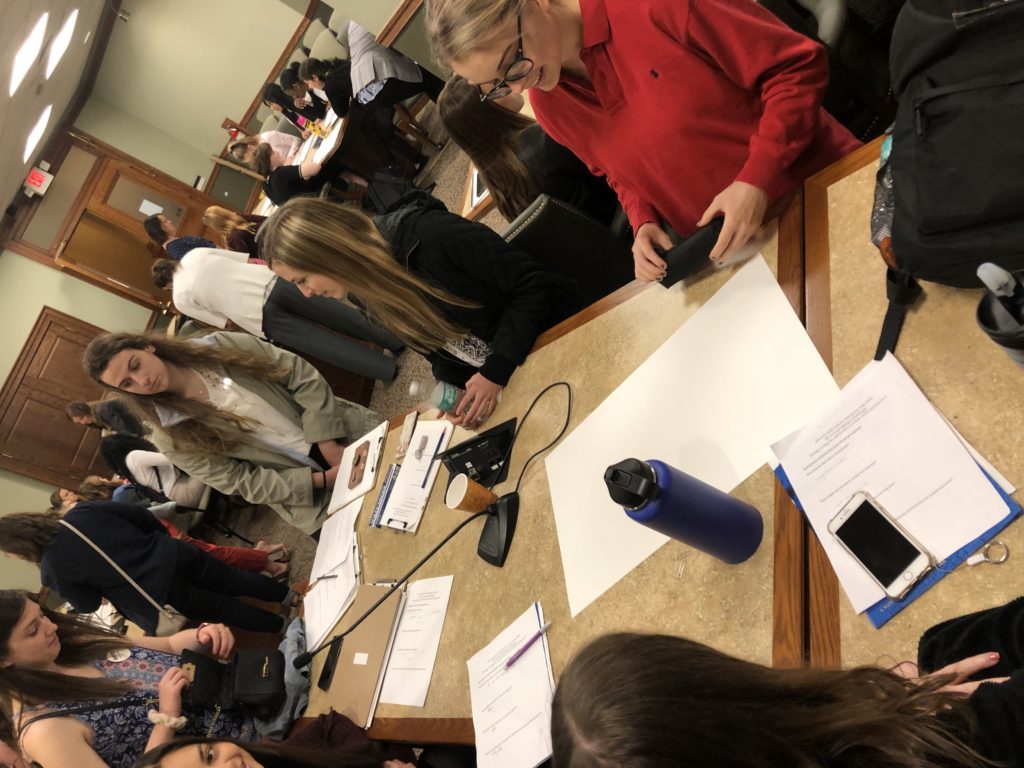
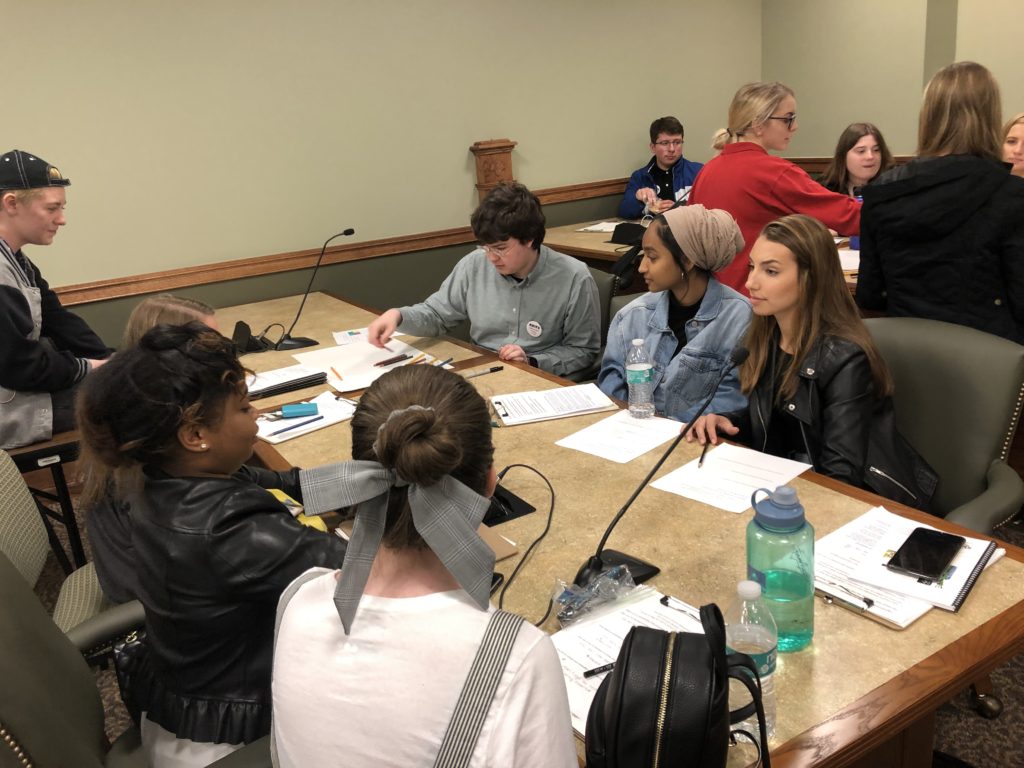
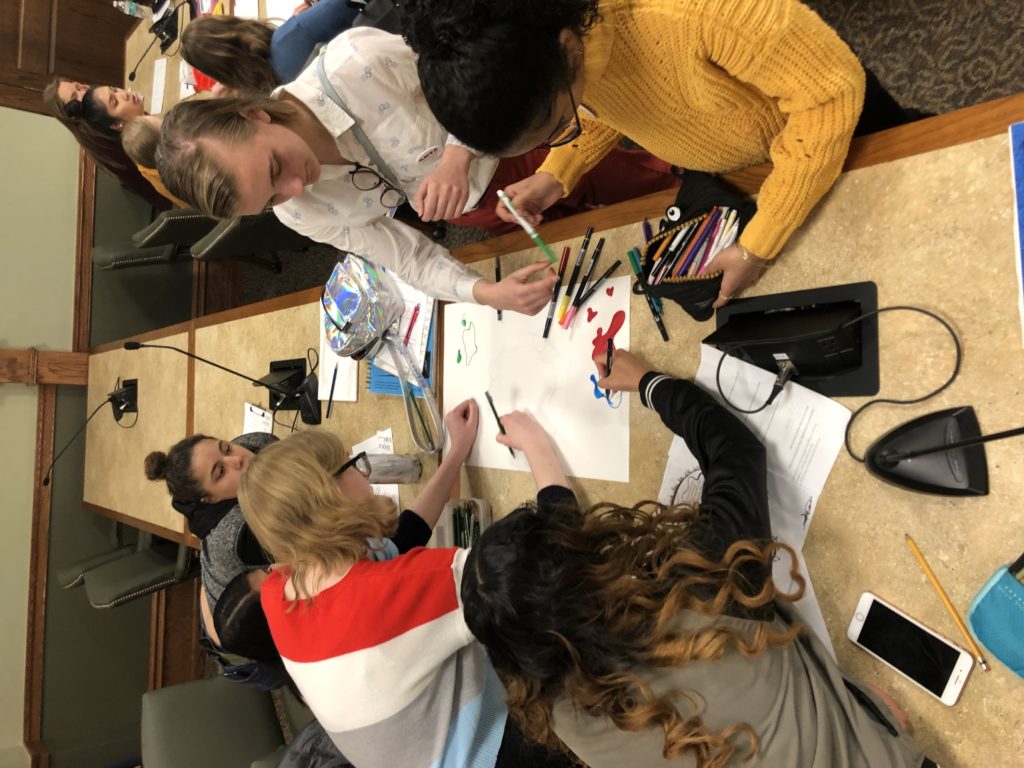
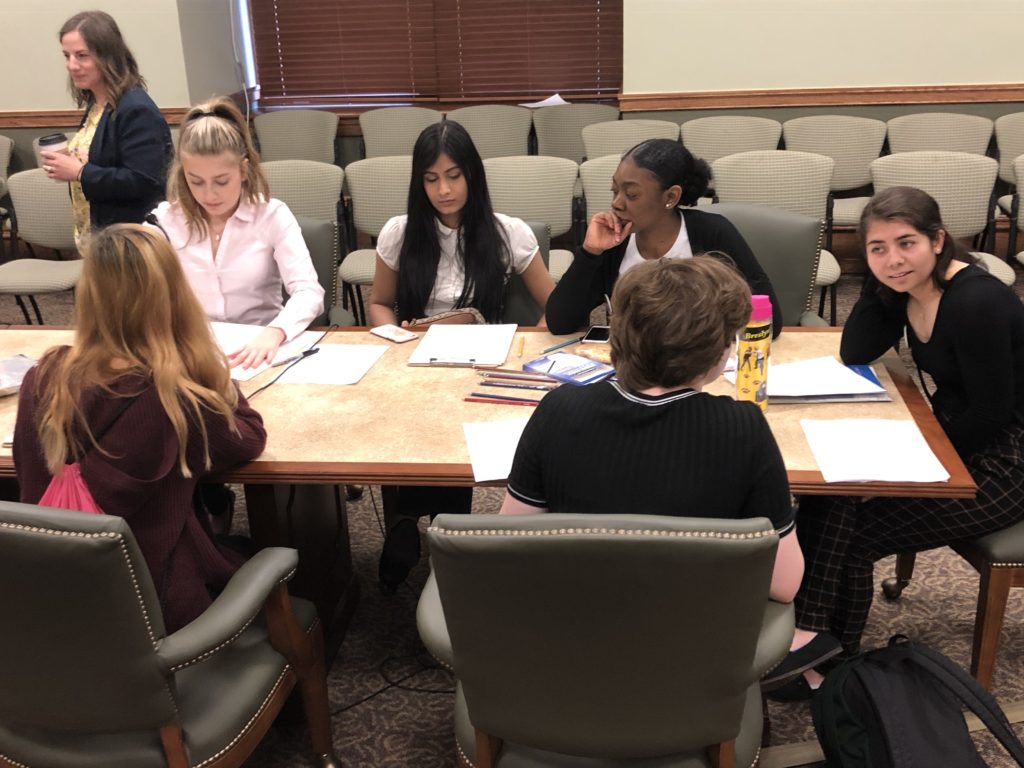
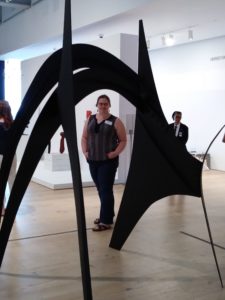
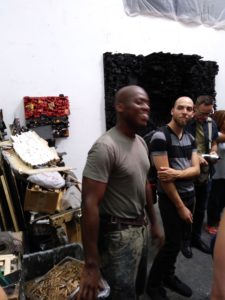

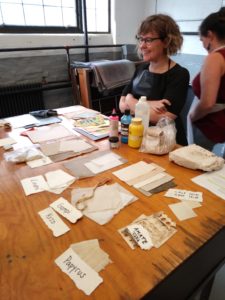
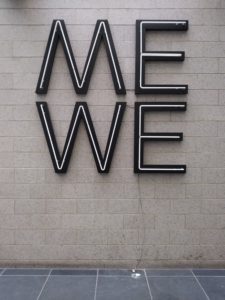
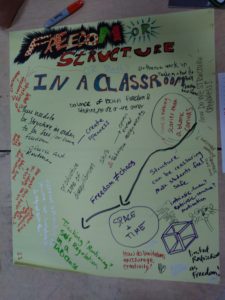
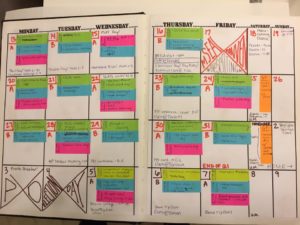
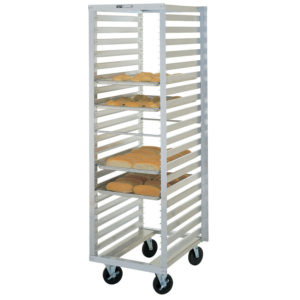
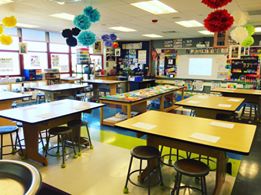

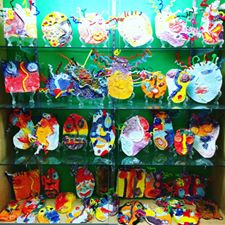
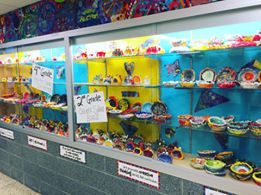
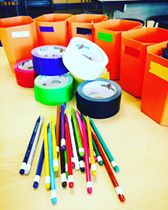
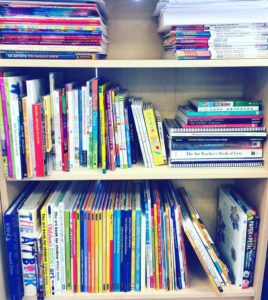

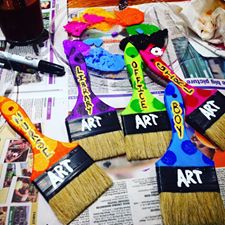
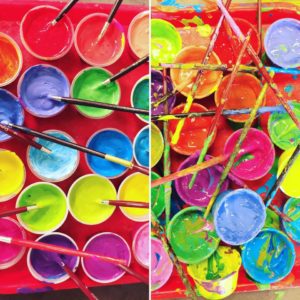
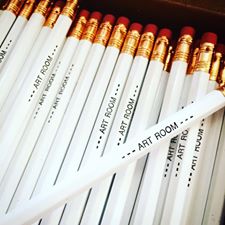
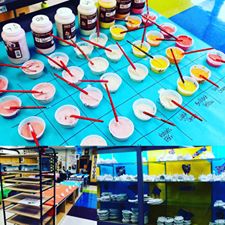
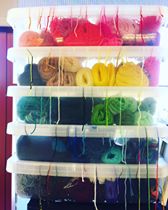
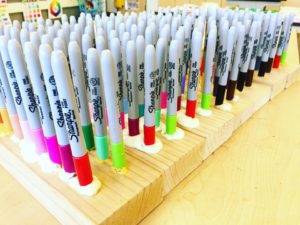
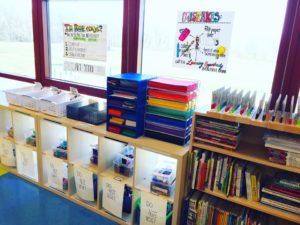
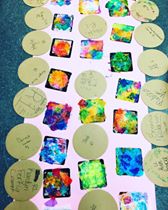

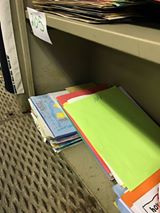
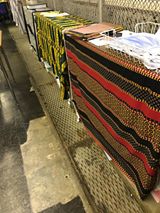
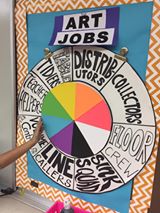
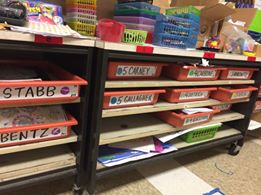
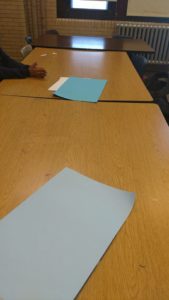
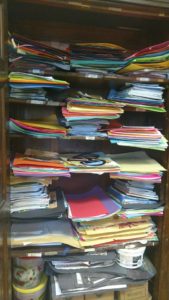
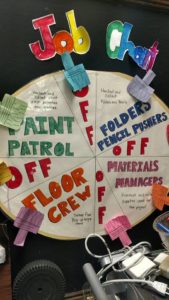
 D5 Creation
D5 Creation